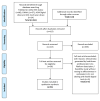Role of Participatory Health Informatics in Detecting and Managing Pandemics: Literature Review
- PMID: 33882600
- PMCID: PMC8432992
- DOI: 10.1055/s-0041-1726486
Role of Participatory Health Informatics in Detecting and Managing Pandemics: Literature Review
Abstract
Objectives: Using participatory health informatics (PHI) to detect disease outbreaks or learn about pandemics has gained interest in recent years. However, the role of PHI in understanding and managing pandemics, citizens' role in this context, and which methods are relevant for collecting and processing data are still unclear, as is which types of data are relevant. This paper aims to clarify these issues and explore the role of PHI in managing and detecting pandemics.
Methods: Through a literature review we identified studies that explore the role of PHI in detecting and managing pandemics. Studies from five databases were screened: PubMed, CINAHL (Cumulative Index to Nursing and Allied Health Literature), IEEE Xplore, ACM (Association for Computing Machinery) Digital Library, and Cochrane Library. Data from studies fulfilling the eligibility criteria were extracted and synthesized narratively.
Results: Out of 417 citations retrieved, 53 studies were included in this review. Most research focused on influenza-like illnesses or COVID-19 with at least three papers on other epidemics (Ebola, Zika or measles). The geographic scope ranged from global to concentrating on specific countries. Multiple processing and analysis methods were reported, although often missing relevant information. The majority of outcomes are reported for two application areas: crisis communication and detection of disease outbreaks.
Conclusions: For most diseases, the small number of studies prevented reaching firm conclusions about the utility of PHI in detecting and monitoring these disease outbreaks. For others, e.g., COVID-19, social media and online search patterns corresponded to disease patterns, and detected disease outbreak earlier than conventional public health methods, thereby suggesting that PHI can contribute to disease and pandemic monitoring.
IMIA and Thieme. This is an open access article published by Thieme under the terms of the Creative Commons Attribution-NonDerivative-NonCommercial License, permitting copying and reproduction so long as the original work is given appropriate credit. Contents may not be used for commercial purposes, or adapted, remixed, transformed or built upon. (https://creativecommons.org/licenses/by-nc-nd/4.0/).
Conflict of interest statement
Disclosure The authors report no conflicts of interest in this work.
Figures
Similar articles
-
Consumer Informatics and COVID-19 Pandemics: Challenges and Opportunities for Research.Yearb Med Inform. 2021 Aug;30(1):210-218. doi: 10.1055/s-0041-1726532. Epub 2021 Sep 3. Yearb Med Inform. 2021. PMID: 34479392 Free PMC article.
-
Defining participatory health informatics - a scoping review.Inform Health Soc Care. 2021 Sep 2;46(3):234-243. doi: 10.1080/17538157.2021.1883028. Epub 2021 Feb 23. Inform Health Soc Care. 2021. PMID: 33622168
-
The Use of Digital Technologies in the Inpatient Setting to Promote Communication During the Early Stage of an Infectious Disease Outbreak: A Scoping Review.Telemed J E Health. 2023 Feb;29(2):172-197. doi: 10.1089/tmj.2021.0615. Epub 2022 Jun 27. Telemed J E Health. 2023. PMID: 35758765
-
Public health intelligence and the detection of potential pandemics.Sociol Health Illn. 2013 Feb;35(2):174-87. doi: 10.1111/j.1467-9566.2012.01536.x. Epub 2012 Dec 20. Sociol Health Illn. 2013. PMID: 23278393
-
Citizens' Adherence to COVID-19 Mitigation Recommendations by the Government: A 3-Country Comparative Evaluation Using Web-Based Cross-Sectional Survey Data.J Med Internet Res. 2020 Aug 11;22(8):e20634. doi: 10.2196/20634. J Med Internet Res. 2020. PMID: 32716896 Free PMC article.
Cited by
-
Defining and Scoping Participatory Health Informatics: An eDelphi Study.Methods Inf Med. 2023 Sep;62(3-04):90-99. doi: 10.1055/a-2035-3008. Epub 2023 Feb 14. Methods Inf Med. 2023. PMID: 36787885 Free PMC article.
-
How Participatory Health Informatics Catalyzes One Digital Health.Yearb Med Inform. 2023 Aug;32(1):48-54. doi: 10.1055/s-0043-1768727. Epub 2023 Dec 26. Yearb Med Inform. 2023. PMID: 38147849 Free PMC article.
References
-
- Kaiser R, Coulombier D, Baldari M, Morgan D, Paquet C. What is epidemic intelligence, and how is it being improved in Europe? Euro Surveill. 2006;11(02):E060202.4. - PubMed
-
- Rortais A, Belyaeva J, Gemo M, Van derGoot E, Linge J P. MedISys: An early-warning system for the detection of (re-) emerging food-and feed-borne hazards. Food Research International. 2010;43(05):1553–6.
-
- Samaras L, García-Barriocanal E, Sicilia M A. Syndromic surveillance using web data: a systematic review. Innovation in Health Informatics. 2020:39–77.
Publication types
MeSH terms
LinkOut - more resources
Full Text Sources
Other Literature Sources


